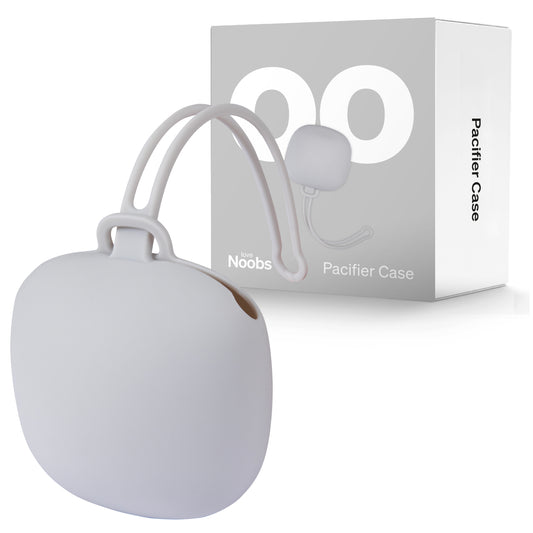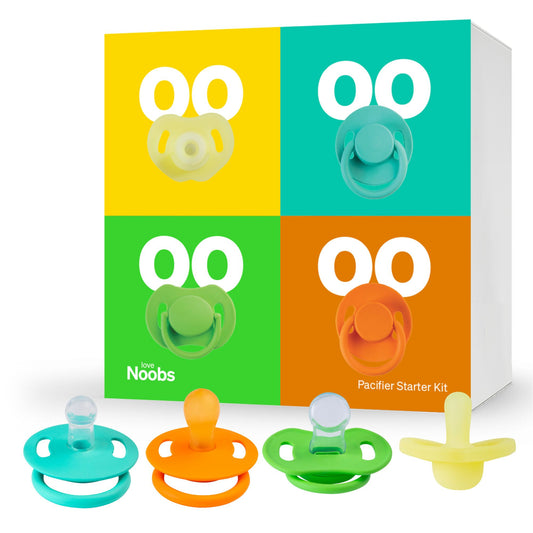There are many different types of pacifiers on the market, and it can be tough to decide which one product is best for your baby and its health. But don't worry - we're here to help you find the right pacifier for your child!
Different types of pacifiers
There are many different types of pacifier packs on the market, different shape and material. So how do you know which one is best for your baby? It can be a tough journey to find a pacifier that does not create nipple confusion. Here are some things to consider when choosing a pacifier:
- The size of the pacifier. Make sure the pacifier is the right size for your baby's mouth. If it's too big for the infant, it could fall out easily, and if it's too small, your baby may have difficulty sucking on it. Pacifiers usually have 3 sizes, 0-6 months, 6-18 months, 18-36 months. The pacifier should be age appropriate.
- The shape of the pacifier. Some pacifiers are shaped more like a nipple, while others are more rounded. Some are orthodontic, meaning they support dental health, and some flat. You'll want to try a few different types to see which one your baby prefers.
- The material the pacifier is made from. Some pacifiers are made from latex, while others are made from soft silicone. Again, it's a matter of babies preference, so you'll want to try out rubber and silicone types to see which one your baby likes best.
- The color of the pacifier. Believe it or not, some babies prefer a certain color of pacifier.
- The design of the pacifier. Some pacifiers have cute designs on them, while others are plainer. Once again, it's a matter of preference, so you'll want to try out a few different types to see which one your baby likes best before ordering a pack.
What to consider when choosing a pacifier for your baby
You want what's best for your baby, and that includes choosing the right pacifier. But how do you know which one is the best product? Here are a few things to consider when selecting a pacifier for your little one:
-The size and shape of the nipple should fit your baby's mouth.
-Choose a firmness that your baby will find comfortable. Some babies like soft pacifiers while others like more firm products.
No matter which type of pacifier you choose for your baby, make sure it is BPA and phthalate-free silicone or latex and meets safety requirements set by the CPSC (Consumer Product Safety Commission). It’s also important to check with your pediatrician before using any type of pacifier or product with your baby.
How to know if your baby likes the pacifier you've chosen
After you've selected a pacifier that meets all the safety requirements, the next step is to figure out if your baby likes it. Every baby is different when it comes to pacifiers, and it can take some trial and error to find the best one. Here are some tips on how to know if your little one likes the pacifier you've chosen:
- Check for signs of acceptance. Does your baby suck on the pacifier? Does he or she hold it in their mouth for more than a few seconds? These are good signs that your baby is comfortable with the pacifier and may even like it!
- Observe how long your baby will use the pacifier. If your baby is happily sucking on the pacifier for more than a few minutes at a time, then they probably like it! On the other hand, if the child only uses it for a few seconds or not at all, then they may not be as fond of it.
- Watch for signs of distress or discomfort. If your baby starts crying or seems agitated after putting in the pacifier, then they may not like the fit or shape of it. This could indicate that you need to try another type or style of pacifier.
- Listen to what other parents have to say about their experiences with different types of pacifiers and their child. Ask friends and family who have an older child what types of pacifiers worked best for them and why. This could help you narrow down which ones might work best for your own little one. You might even ask for different kinds of pacifiers that they like for your registry.
By following these tips, you'll be able to determine whether your baby enjoys the pacifier that you've chosen for them!
How to clean and store a pacifier
When it comes to keeping your baby's pacifier clean and safe, there are a few guidelines you should follow. If you start out with the right cleaning protocol, your baby will have a safe, germ-free pacifier.
First, you'll want to make sure that you inspect your baby's pacifier before each use. Look for any cracks or tears in the rubber or plastic parts, as these can harbor bacteria and dirt. Discard any damaged pacifiers right away and replace them with a new one.
When it comes time to clean your baby's pacifier, use warm soapy water and a cloth to wipe down the surface of the pacifier. You can also use a bottle brush if necessary. Avoid using harsh chemicals or boiling the pacifier, as this can damage the material or leave it susceptible to bacteria growth.
Once the pacifier is cleaned, rinse it off with tap water and allow it to air dry completely before giving it back to your baby. When storing your baby's pacifiers, keep them away from direct sunlight or heat sources such as a stove top or radiator. This will help protect against germs and bacteria growth on the rubber or plastic parts of the pacifier.
You should also store them in an airtight container when they're not in use, so they stay clean and free from dirt and dust particles.
By following these guidelines for cleaning and storing your baby's pacifiers, you can ensure that they remain germ-free and in good condition for years to come!



